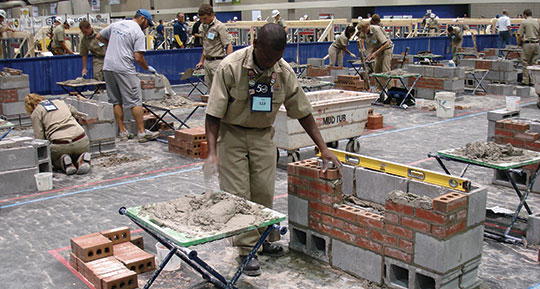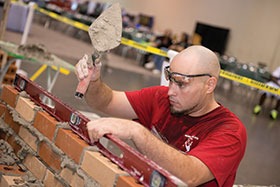Workforce Development
A Masonry Workforce for Tomorrow
In an effort to improve workforce development challenges created by a recession and an aging workforce, the Mason Contractors Association of America recently announced an initiative for training programs at the high school level that will feed graduates into apprenticeship opportunities across the country.
 |
| Shown is a SkillsUSA competitor in action |
The Mason Contractors Association of America (MCAA) has partnered with the National Center for Construction Education and Research (NCCER) to implement training programs and help individuals get the training and assessments they need to build successful careers in the construction industry. The MCAA is adapting the NCCER’s current industry-standardized curricula and assessments to create a jointly endorsed masonry training and credentialing program.
The partnership comes at a time when the industry is struggling with workforce development issues created by a number of factors, including the recession. During the downturn in the economy, some marketplaces had to let go of as much as 70 percent of their workforce, says Jeff Buczkiewicz, MCAA president and CEO. Many left the industry for jobs in other fields, including fracking: “The industry is still seeing shortages in the workforce, and we probably won’t get some of those folks back.”
Another factor in the shortage of skilled workers is an aging population. “As an industry, we know our craft people’s median age continues to go up and not down,” says Buczkiewicz. “It’s not curving down, the recession compounded our problem by not permitting us to train and intergrate the new workforce. As a result, we need to work extra hard to make sure we catch our recruitment levels to levels that are desired.
“Our craft is under employed, and there will definitely be a shortage of skilled crafts people out there,” he continues. “We’re trying to get ahead of the curve and feed the apprentice programs as the economy rebounds.”
A major aspect of the workforce development initiative will promote masonry training at secondary and post-secondary education levels, ensuring seamless articulation between Secondary Career and Technical Education (CTE) programs and Post-secondary Technical College programs.
“A lot of schools have some type of construction class or another, but they’ve taken a beating and had their budgets cut,” Buczkiewicz says, adding that high schools have traditionally focused more on preparing college-ready students more than workforce-ready students.
Optimally, the program will target high school juniors and seniors, with the first year concentration on core curriculum and the second year on volume one of the NCCER curriculum. Once a student completes the two-year program, he qualifies to be accepted into an NCCER apprentice program anywhere in the country as a second year apprentice, rather than just a first year apprentice. This gives him the advantage to quickly move into a career following high school graduation.
“It will establish an opportunity to work with local contractors and state chapters to provide feeder groups,” Buczkiewicz says, noting that work experience hours normally earned as a first year apprentice can be made up, while the second year apprentice simultaneously earns a living. “That should appeal to high schools and to school counselors; that should be very attractive to them.”
The MCAA will sponsor a minimum of 15 programs in four Tennessee school districts beginning this fall, says Terry Ruppel, MCAA’s director of training and workforce development for the Tennessee programs. Participating school districts include the counties of Shelby (Memphis), Marion, Maury and Franklin.
The MCAA’s sponsorship requires that it support all construction trade programs available at each school, not just masonry, though the initiative is designed to expand and strengthen the masonry training programs being offered. The project includes overseeing individual certification for teachers and project certification for construction programs, as well as state certification in those trades, Ruppel says.
“There are about 200 (high school construction trade) teachers in the state of Tennessee and about 300 programs being offered at the high school level,” he says. “We’ll reach out to all of them. He adds that, although some initial rollout in Tennessee occurred in the spring, 2014-15 will be the first full school year for the sponsored training programs.
The program has a post-secondary aspect as well, and individuals have the option to continue their education after high school by completing volumes two and three of the NCCER curriculum at a community college offering the training program or at any other NCCER sponsored training program, says Buczkiewicz.
 |
|
| Shown is a 3rd year apprentice competing in the MAF Apprentice Competition at the Southeast Building Conference in 2013 |
The state of Florida serves as a model for the NCCER partnership, having found great success since the training programs went into schools there in 2004, according to Al Herndon, regional apprentice representative for the Florida Masonry Apprentice and Educational Foundation. Today, the two organizations are sponsoring 130 training programs across the state.
“We knew we were going into a recession, and now that we’re coming out of it, the system is in place; we’ve got a niche,” Herndon says. “We help public schools in Florida, and it works very well.” So well, in fact, that 1,802 students in Florida schools received credentials in the training program last year alone. “We’ve kind of impressed the NCCER and the Department of Education.”
While Florida has a solid apprentice program in place, plans to strengthen the masonry apprenticeships do exist, said Herndon: “Not all students go right into an apprentice program. They’re kids, and they change their minds. They’ll graduate high school and do other things like go and work at Burger King. Then they realize they need a career.”
The masonry training programs in the Sunshine State soon will benefit from additional funding created by the passing of the Concrete Masonry Education Act in June, says Pat McLaughlin, executive director of Masonry Association of Florida and Florida Masonry Educational Foundation.
“It took four years to pass, but we had a lot of support from all three branches of state government,” McLaughlin says. The new law allowed for the creation of the Florida Masonry Education Council, a 501(c)(3) corporation designed to educate and promote masons in the state of Florida. The public/private partnership will be funded by members of the masonry industry who voluntarily contribute a penny for every block made in the state. The contributions are expected to total $1 million annually, McLaughlin says.
“This will take masonry in the state of Florida to another level, no doubt about it,” he says, adding that the law also will formally connect the public/private partnership with workforce boards across the state, connecting employers to employees.
“This is an education bill, and this is a jobs bill,” he says. “Florida contractors are already excited, because it can open up opportunities for all the trades, not just masonry.”
Instrumental in making this joint effort possible was the National Concrete Masonry Association’s (NCMA) Education and Research Foundation, which provided partial funding through three grants, according to Dennis Graber, director of technical publications for the association. The grant money was needed to develop three volumes of curricula for the training program, taking the MCAA’s curriculum and incorporating parts of it into the new NCCER Masonry books.
“I think the partnership is terrific,” says Graber. “The NCCER has a vehicle for administering these types of credentials, and it really makes sense for them to work together on it.”
Graber agrees that the training programs will be a boost for the industry overall: “It’s going to help a lot with increasing the number of masons we have, plus the NCCER credential will be transferable from state to state. As the mason moves from one state to another, the credential will go with him,” he says, noting that many state certifications are valid only in the issuing state.
While Tennessee will serve as a test market, so to speak, the MCAA has hopes of expanding the training program soon to high schools in Kentucky and Texas, says Buczkiewicz. He says the goal is to have 50 instructors and about 3,500 students participating in MCAA sponsored programs by the end of the first year.
K.K. Snyder is a freelance writer based in Albany, Ga. For more information on the MCAA’s workforce development efforts, contact Jeff Buczkiewicz, jeffb@masoncontractors.org.